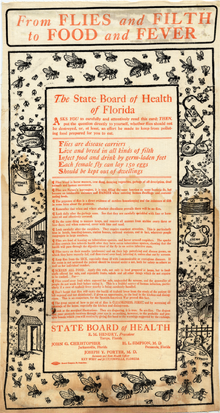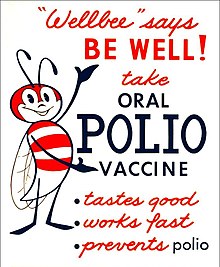Public health


Public health is the science dealing with prevention when there is a disease that is a threat to the overall health of a community, as well as prolonging life and promoting health.[1] The aims are achieved through the organized efforts and informed choices of society, public and private organizations, communities and individuals.
It bases on health analysis of a handful of people or all the inhabitants of several continents rather than on an individual. Public health includes such parts as epidemiology,[2][3][4][5][6][7][8] biostatistics,[9] health services, environmental, social, behavioral, and occupational health.[10]
Public health intervention prevents rather than treats a disease through surveillance of cases and promotes healthy behaviors such as hand washing, vaccination programs and distribution of condoms. In outbreaks of an infectious disease, treating a disease may be vital to preventing it in others.
Most countries have their own government public health agencies, sometimes known as ministries of health, to respond to domestic health issues. Many diseases are preventable through simple, non-medical methods. Public health plays an important role in disease prevention efforts in the developing world and in developed countries, through local health systems and through international non-governmental organizations. In the developing world, there may not be enough trained health workers or monetary resources to provide a basic level of medical care and disease prevention.
History of public health
[change | change source]Public health has roots in antiquity. From the beginning, human civilization recognized that polluted water and lack of proper waste disposal spread communicable diseases. Early religions attempted to regulate behavior related to health, from types of food eaten, to behaviors, such as drinking alcohol or sexual relationships. Governments placed responsibility on leaders to develop public health policies and programs in order to gain some understanding of the causes of disease, ensure social stability prosperity, and maintain order.
The Chinese developed the practice of variolation following a smallpox epidemic around 1000 BC. The practice of vaccination did not become prevalent until the 1820s. During the 14th century Black Death in Europe,[11][12] burning parts of cities resulted in benefit, since it destroyed the rodent infestations. The development of quarantine in the medieval period restricted effects of other infectious diseases.
Later people started building sewers and irrigation, the regular collection of garbage, incineration or disposal, providing clean water and draining standing water to prevent the breeding of mosquitos. The industrial revolution initially caused the spread of disease through large conurbations around workhouses and factories.
Modern public health
[change | change source]The increase in average life span in the 20th century is credited to public health achievements, such as vaccination programs and control of infectious diseases, effective safety policies of motor vehicle and occupational safety, improved family planning,[13] smoke-free measures, and programs on decreasing chronic disease such as cancer, heart disease and more physical exercise.
Sometimes, the developing world is affected by largely preventable infectious diseases, due to malnutrition and poverty. The focus of public health has moved from individual behaviors and risk factors to population-level issues such as inequality, poverty, and education. There is recognition that our health is affected by where we live, genetics, our income, our educational status and our social relationships.
England
[change | change source]Public health in England is mostly run by local government since 2012.[14] They pay for
- health visitors and school nurses
- drug and alcohol addition treatment
- Raising awareness for other substance use, such as smoking
- sexual health services
- physical activity
- suicide prevention
- health protection
Education and training
[change | change source]Schools of public health offer:
- Professional degrees are oriented towards practice in public health settings: the Master of Public Health (M.P.H.),[15][16][17][18][19] Doctor of Public Health (Dr.PH.)[20][21] and the Master of Health Administration (M.H.A.). They deal with public health in health departments, managed care and community-based organizations, hospitals and consulting firms.
- Academic degrees are oriented towards the scientific basis of public health and preventive medicine,[22] research, university teaching in graduate schools, policy analysis and development, and other high-level public health positions. Examples of academic degrees are the Master of Science (M.S.), Doctor of Philosophy (Ph.D.), and Doctor of Science (Sc.D.).
Public health programs
[change | change source]
Most governments recognize the importance of public health programs in reducing the incidence of disease, disability, and the effects of aging, although public health generally receives significantly less government funding compared with medicine. In recent years, public health programs providing vaccinations have made strides in promoting health, including the eradication of smallpox.
An important public health issues facing the world currently are HIV/AIDS, antibiotic resistance, leading to the re-emergence of diseases such as Tuberculosis,[23] diabetes.[24][25][26][27] As non-communicable diseases caused by smoking have been threatening public health, public health started controlling smoking. The global health system needs to find a way to even out communicable and non communicable diseases. Many nations have implemented major initiatives to cut smoking, such as increased taxation and bans on smoking in some or all public places.
References
[change | change source]- ↑ Detels, R., Beaglehole, R., Lansang, M. A., & Gulliford, M. (2011). Oxford textbook of public health. Oxford University Press.
- ↑ John, M. L. (2001). A dictionary of epidemiology. Oxford University Press.
- ↑ Thrusfield, M. (2018). Veterinary epidemiology. John Wiley & Sons.
- ↑ Berkman, L. F., Kawachi, I., & Glymour, M. M. (Eds.). (2014). Social epidemiology. Oxford University Press.
- ↑ Willett, W. (2012). Nutritional epidemiology. Oxford University Press.
- ↑ Beaglehole, R., Bonita, R., & Kjellström, T. (1993). Basic epidemiology (pp. 133-142). Geneva: World Health Organization.
- ↑ Lilienfeld, D. E., Lilienfeld, D. E., Stolley, P. D., & Lilienfeld, A. M. (1994). Foundations of epidemiology. Oxford University Press, USA.
- ↑ Rothman, K. J. (2012). Epidemiology: an introduction. Oxford University Press.
- ↑ Rosner, B. (2015). Fundamentals of biostatistics. Nelson Education.
- ↑ Schilling, R. S. F. (Ed.). (2013). Occupational health practice. Butterworth-Heinemann.
- ↑ Huppert, G. (1998). After the black death: a social history of early modern Europe. Indiana University Press.
- ↑ Kelly, J. (2005). The Great Mortality: an intimate history of the Black Death. Fourth Estate.
- ↑ Abma, J. C. (1997). Fertility, family planning, and women's health: new data from the 1995 National Survey of Family Growth (Vol. 19). National Ctr for Health Statistics.
- ↑ "Healthy Lives, Healthy People: update and way forward". GOV.UK. Retrieved 2023-02-06.
- ↑ Moser, J. M. (2008). Core academic competencies for master of public health students: one health department practitioner’s perspective. American Journal of Public Health, 98(9), 1559-1561.
- ↑ Leon, J. S., Winskell, K., McFarland, D. A., & Rio, C. D. (2015). A case-based, problem-based learning approach to prepare master of public health candidates for the complexities of global health. American journal of public health, 105(S1), S92-S96.
- ↑ Villanueva, A. M., Hovinga, M. E., & Cass, J. L. (2011). Master of public health community-based practicum: students' and preceptors' experiences. Journal of Public Health Management and Practice, 17(4), 337-343.
- ↑ Zwanikken, P. A., Huong, N. T., Ying, X. H., Alexander, L., Wadidi, M. S. A., Magaña-Valladares, L., ... & Leppink, J. (2014). Outcome and impact of Master of Public Health programs across six countries: education for change. Human resources for health, 12(1), 1-10.
- ↑ Woodhouse, L. D., Auld, M. E., Livingood, W. C., & Mulligan, L. A. (2006). Survey of accredited master of public health (MPH) programs with health education concentrations: a resource for strengthening the public health workforce. Health promotion practice, 7(2), 258-265.
- ↑ Roemer, M. (1999). Genuine professional doctor of public health the world needs. Journal of Nursing Scholarship, 31(1), 43.
- ↑ Berman, P., & Frenk, J. (2018). The new Harvard doctor of public health: lessons from the design and implementation of an innovative program in advanced professional leadership. Public Health Reports, 133(6), 759-766.
- ↑ Cooper, K. H. (2010). Controlling Cholesterol: Dr. Kenneth H. Cooper's Preventative Medicine Program. Bantam.
- ↑ Reported tuberculosis in the United States (1996). US Department of Health and Human Services, Public Health Service, Centers for Disease Control and Prevention, National Center for Prevention Services, Division of Tuberculosis Elimination.
- ↑ National Diabetes Data Group (US), National Institute of Diabetes, Digestive, & Kidney Diseases (US). (1995). Diabetes in America (No. 95).
- ↑ Holt, R. I., Cockram, C., Flyvbjerg, A., & Goldstein, B. J. (Eds.). (2017). Textbook of diabetes. John Wiley & Sons.
- ↑ DeFronzo, R. A., Ferrannini, E., Zimmet, P., & Alberti, G. (Eds.). (2015). International textbook of diabetes mellitus. John Wiley & Sons.
- ↑ Wass, J. A., & Stewart, P. M. (Eds.). (2011). Oxford textbook of endocrinology and diabetes. Oxford University Press.